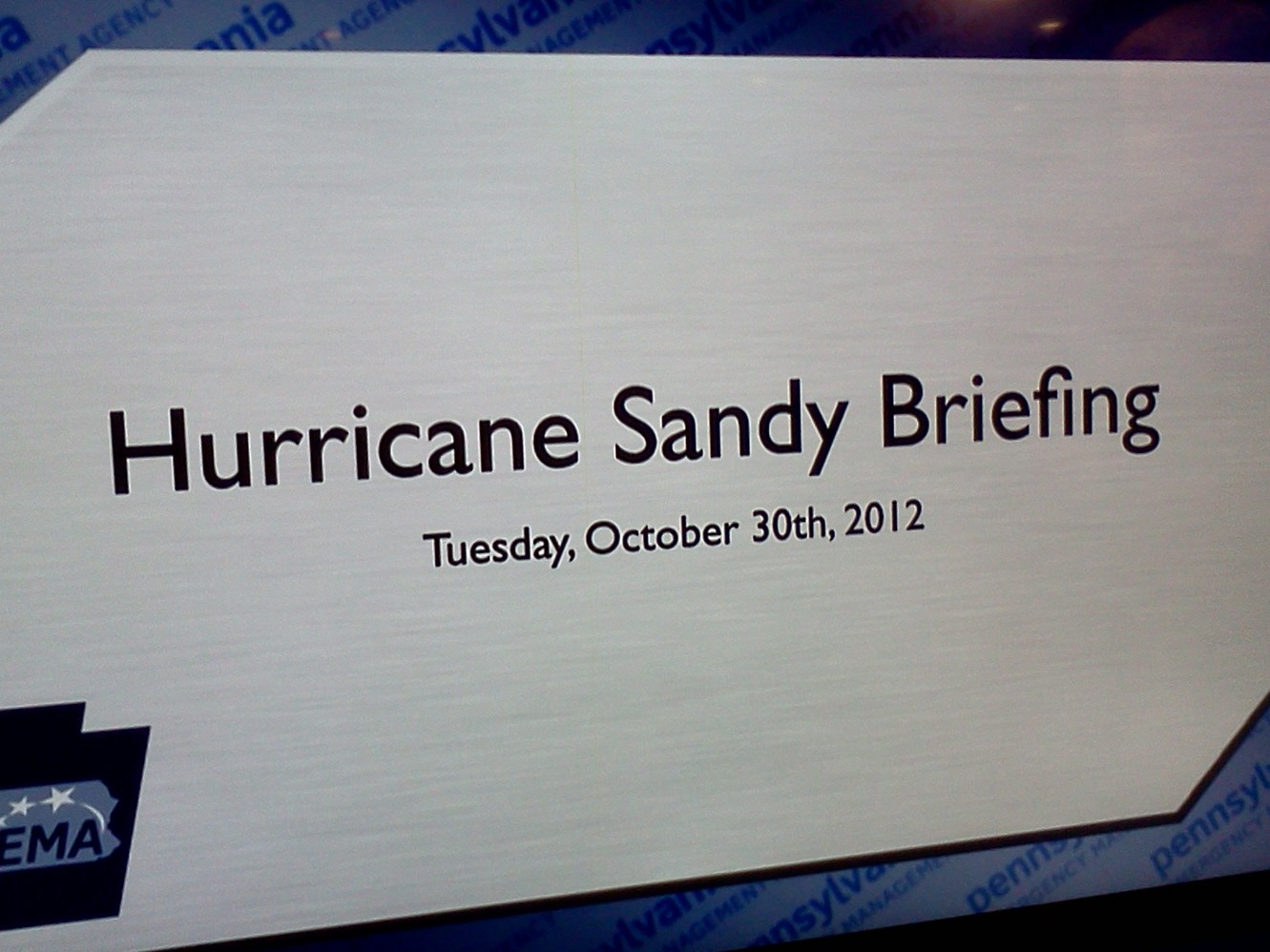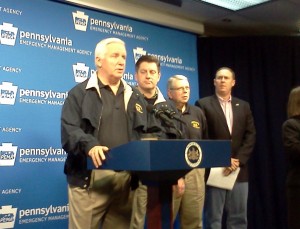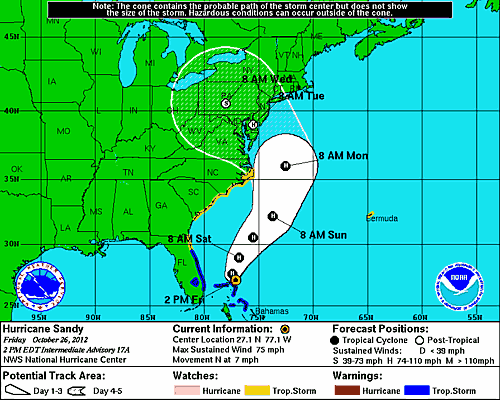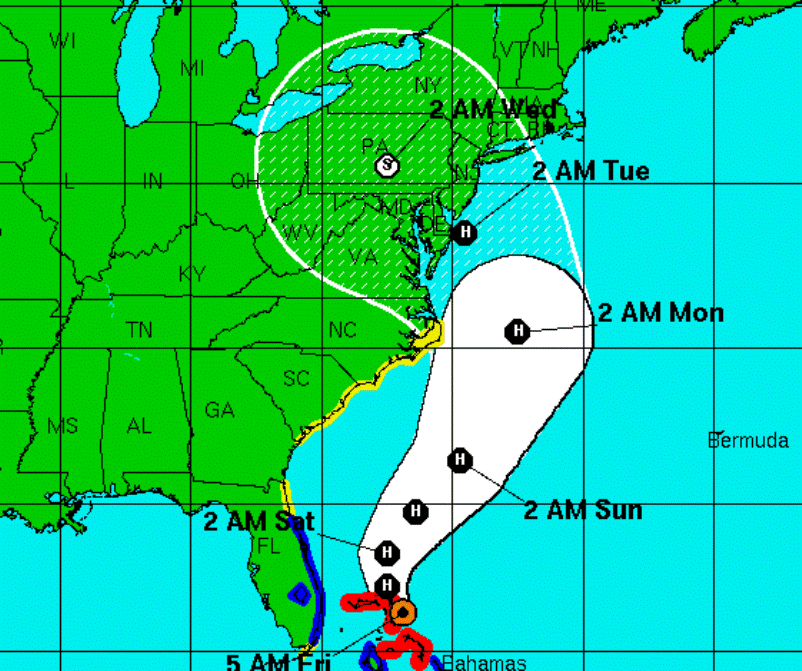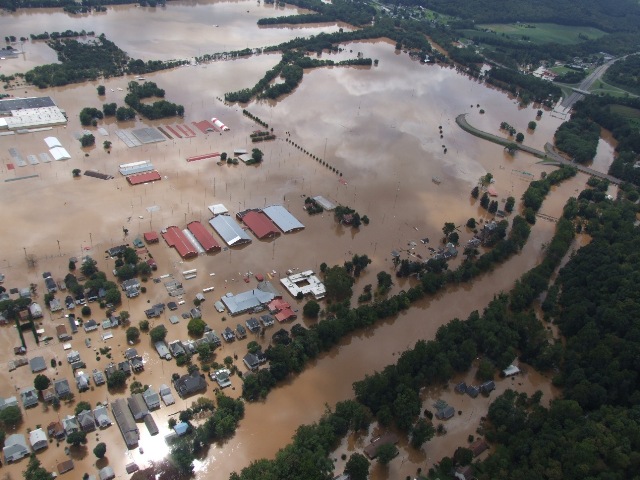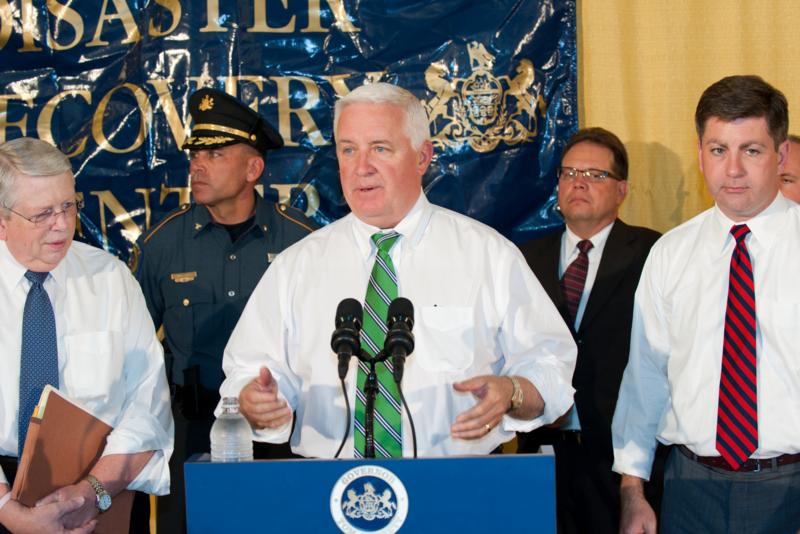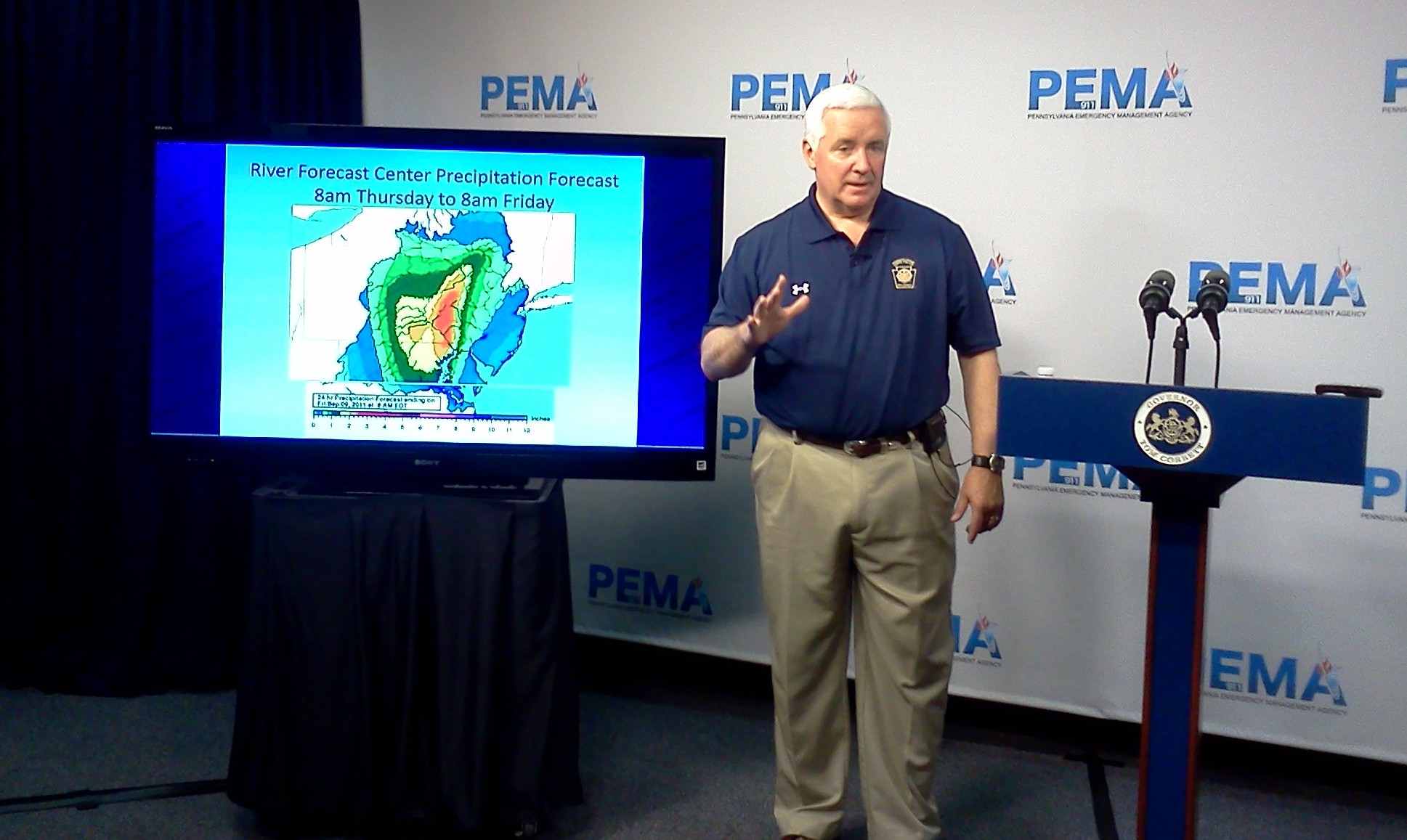Posts
Worst is Over, PA to Assist Neighboring States
/in News /by PAMattersState emergency management officials cited significantly diminished winds as, as the storm that used to be Hurricane Sandy slowly moved through western Pennsylvania and into New York.
There are reports of minor flooding across the state’s southern counties and 1.25-million Pennsylvania households were without power as of the midday briefing. 900-people have also sought aid in 57-shelters that have been established across the state.
But the problems are much worse in neighboring New York and New Jersey. “There are two mega-shelters being established to house people coming in from out-of-state,” Governor Tom Corbett explained. One, at West Chester University, will house up to 1,300 displaced New Jersey residents. Another, at East Stroudsburg University, will house up to 500 displaced New Yorkers.
Pennsylvania is also sending those states 35- ambulances and a variety of incident management teams, according to PEMA director Glenn Cannon.
A state of major disaster has already been declared in New York and New Jersey. Pennsylvania’s would-be major disaster declaration will have to wait until the damages are tallied, but Governor Corbett says the state will at least receive federal assistance for its storm prep. “Frankly I believe our preparation for the storm, in many respects, kept much of the damage in check, particularly when it comes to life and injuries.”
At least three Pennsylvania deaths have been confirmed in connection with the storm. Two of them involve falling trees, the third was the result of a traffic accident. That number may rise in the hours ahead.
Corbett will be at Ft. Indiantown Gap, this afternoon, to visit with some of the 2,000 National Guard troops that have been activated for the disaster response. Then it’s back to the PEMA emergency operations center for an evening briefing on the storm, and Corbett plans to tour some of the hardest-hit areas of the state on Wednesday and Thursday.
State Officials, Utilities Prepare for Major Storm
/in News /by PAMattersUtilities are preparing for the potential of significant damage and power outages as Hurricane Sandy moves up the coast. They’re bringing in extra crews and following the forecast.
PPL spokesman Joe Nixon says they have sister utilities in Kentucky and they’re already arranging to have them come in. They’re also reaching out to the western states.
First Energy is taking similar steps. Spokesman Scott Surgeoner says they’re moving crews in from service areas not impacted by the storm to those areas most likely to be hit. He says they’re also working with mutual assistance organizations to have additional crews ready to restore service if needed.
The storm will be the first major test for changes made after Hurricane Irene, Tropical Storm Lee and the October snowstorm last year. First Energy has a 24 hour outage center on its home page that can be accessed by smart phone. The utility has agreements to place staff at a number of county emergency management offices to aid in coordinating power restoration. PPL has added capacity to its customer contact center to better handle high volume periods.
The utilities want people to notify them if their power goes out. Customers of First Energy utilities can call 1-888-544-4877. The number connects to an interactive system. Customers can also use the outage center on line.
PPL customers can call 1-800-342-5775. They can also use the on line outage center.
Despite the best efforts of the utilities, there could be prolonged power outages. If you lose service, Surgeoner says don’t turn to unsafe methods of keeping warm. He says propane ovens or stoves should not be used to try to heat the house; they can cause carbon monoxide fumes to build up. He says generators must be installed properly and used in well ventilated areas where fumes cannot come into your living space.
All downed power lines should be treated as live wires. Damaged power lines should be reported to the utility. Downed wires can also be reported to 911.
The Pennsylvania Emergency Management Agency is also urging residents to prepare. You can get a check list on line.
Governor Corbett toured areas hit by Hurricane Irene and Tropical Storm Lee last year and urged people to be prepared for this storm.
The Federal Emergency Management Agency is urging preparations all along the East Coast.
Latest Forecast Tracks Bring Sandy to Pennsylvania on Tuesday & Wednesday
/in News /by Brad ChristmanThe effects of Hurricane Sandy may reach Pennsylvania as early as Sunday, but according to the National Hurricane Center the storm itself is expected to come ashore near the New Jersey-Delaware border and then track directly over Pennsylvania late Tuesday and into Wednesday.
The main concern is that the tropical storm could collide with a westward-moving early winter system and park itself over the region for days, bringing heavy rains, winds and possibly snow in higher elevations. Officials are urging everyone in the path of Sandy to use their time wisely this weekend, preparing emergency kits with at least three days of drinking water and other necessities, as well as clearing storm drains and spouting, which may be clogged with fallen leaves.
A spokesperson for the Pennsylvania Emergency Management Agency says this potential “superstorm” could bring prolonged power outages that may last several days.
Hazard Mitigation Is Part of Post-Flood Follow Up
/in News /by PAMattersIn the aftermath of a disaster, clean up is the main focus. But officials are already looking at ways they can prevent some of the devastating flooding from happening again. Tropical Storm Lee brought more than a foot of rain to parts of Pennsylvania, but some of the flooding was made worse by other factors according to Pennsylvania Emergency Management Agency Director Glen Cannon.
Cannon says the levees along the Susquehanna did protect a number of people, but the system being incomplete caused severe damage for other people. He says it funneled the water down into a channel, increasing the speed and causing the water to back up into other tributaries above those levees, and flood in places that had never been flooded before.
Cannon says PEMA is actively working with the Federal Emergency Management Agency on hazard mitigation. He says they don’t want to wait until the disaster is over.
Cannon says as they figure out the dollar value of the disaster, which is going to be hundreds of millions of dollars, ten percent of it will be given back in the form of money to be used for disaster mitigation projects across the Commonwealth.
Cannon says hazard mitigation applications must come to PEMA from the local and county governments. He adds a county must have its own mitigation plan to be eligible to receive some of the funding. But he says that should not be a problem in Pennsylvania. The state hired a contractor to work with the counties to make sure their plans were in place.
Cannon spoke at a recent joint hearing of the Senate and House Veterans Affairs and Emergency Preparedness Committee, which is considering a state disaster assistance program to fill the gap when disaster fall below the federal threshold for aid.
Governor Tom Corbett on assistance available to those affected by flood waters in Pennsylvania
/in Ask the Governor, Media, News, Video /by PAMattersobject width=”560″ height=”345″>
Disaster Recovery Centers Now Open
/in News /by PAMattersAs Pennsylvanians rebuild from the recent flooding disaster, seven Disaster Recovery Centers have opened in some of the hardest hit areas of the state. “We are going to have our agencies right in there in these centers, to use it as one-stop shopping as much as we can,” Governor Tom Corbett explained on Radio PA’s monthly Ask the Governor program.
15-state agencies will be working alongside FEMA Individual Assistance Specialists at the DRCs. “People can go in and say I lost my driver’s license, I need assistance, I need to sign up, or whatever,” Corbett says. “Under federal regulation, an individual can get up to $30,200, because of this storm, if they have the damage.” Documentation of that damage is critical. “If people are listening to this, and they have damage, and they haven’t taken photographs, take the photographs,” Corbett recommends.
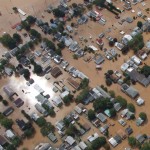
The Susquehanna River overtook parts of Bloomsburg, Columbia County. Now, area residents can visit a Disaster Recovery Center at the Columbia County Agricultural Center on Sawmill Rd.
The governor says the federal government has been responsive in the wake of Tropical Storm Lee. “I was in Shanksville with the President when he came in on Sunday,” Corbett explains, “We talked to him, I talked to his chief of staff, and was assured that we’d get the assistance as soon as everything was there, and we got the material to them very quickly.”
Governor Corbett says PEMA and FEMA have been working together closely since Hurricane Irene hit before Labor Day. It was the remnants President Barack Obama has issued two disaster declarations for this latest round of flooding. One makes federal aid available to individuals, the other to local and state governments, as recovery efforts continue.
Anyone planning on stopping by a Disaster Recovery Center should first register with FEMA, online. The DRCs are open in Bloomsburg, DuShore, Harrisburg, Montoursville, Nanticoke, Towanda and Tunkhannock. Check the addresses below for the disaster center nearest you:
Wyoming County Tunkannock Area School District Administration Office 41 Philadelphia Avenue Tunkhannock, PA 18657 Bradford County Towanda Fire Department 101 Elm St., Towanda PA 18848 Luzerne County Community College 1334 South Prospect Street Nanticoke, PA 18634 Dauphin County Harrisburg East Mall 3501 Paxton Street Harrisburg, PA 17111 Lycoming County 740 Fairfield Road Montoursville, PA 17754 Columbia County Agricultural Center 702 Sawmill Road Bloomsburg, PA 17815 Sullivan County at Loyalsock State Forest District Office 6735 RT. 220 Dushore, PA 18626PA Braces for Life-Threatening, Record-Breaking Floods
/in News /by PAMattersIt’s a Level One situation at the PEMA emergency operations center in suburban Harrisburg. That’s the highest level possible for a state disaster response. “By comparison, 11-days ago, Hurricane Irene only reached a Level Two here in Pennsylvania,” Governor Tom Corbett said at an afternoon media briefing from the PEMA headquarters. The last time the emergency operations center was operating at Level One was 9/11/01.
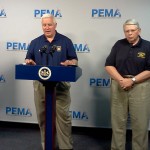
Gov. Corbett and PEMA director Glenn Cannon brief the media on the flooding in central and northeastern PA.
Governor Corbett says the state faces a clear public health emergency. “Sewage treatment plants, such as the one near Hershey, are underwater and no longer working,” Corbett says, “As you know flood water is toxic.” The governor’s message was clear: stay out of the flood water unless you are being rescued.
So far three deaths have been attributed to the flooding. Two of those deaths are in Lancaster County; the third is in Dauphin County, though PEMA director Glenn Cannon says they are as of yet unconfirmed. Almost every town along the Susquehanna River has experienced flooding, but the situation is expected to only get worse until the river crests.
By Friday morning, 1,200 National Guard troops will have been activated. 400 of them are already assisting in the evacuation and protection of thousands of Wilkes-Barre residents, who are evacuating low-lying areas. Governor Corbett has been in contact with federal officials, and says FEMA is flying in pallets full of water and MRE’s (meals, ready-to-eat). The supplies are being dropped off at Ft. Indiantown Gap, and will be distributed to the county level as needed.
Pennsylvania Emergency Management Agency says Get Ready for Storm Season
/in News /by PAMattersHurricane season planning is not just for people who live on the coast line. The Pennsylvania Emergency Management Agency is reminding state residents they need to have a plan as well.
While the state rarely gets a direct hit from a hurricane, it does see tropical storms and tropical depressions with large amounts of rain, damaging winds and even the possibility of a tornado. These conditions can lead to flooding and power outages.
PEMA Director Glenn Cannon says it’s important to have a plan in place for your family and an emergency kit that could sustain them for at least 72 hours.
Cannon says that kit should include flashlights and a battery operated radio, extra batteries, a first aid kit and manual, emergency food and water, a manual can opener, essential medications, cash and credit cards, important documents and sturdy shoes.
Cannon says you should also develop a family plan that identifies a place to meet and a way to communicate if you get separated.
Tornado planning should include the identification of a safe shelter. People who have a basement should know the safest place to take cover. People without a basement should identify an interior room at the lowest level that provides protection. People in mobile homes should know where the nearest sturdy building or storm shelter is located.
Cannon adds many Pennsylvanians vacation at the shore and they should be prepared if they find themselves in the direct path of a hurricane. He says they should monitor weather forecasts, know where the evacuation routes and shelters are located in the town they’re visiting and keep their vehicle fueled and ready.
You can learn more about hurricane and summer storm preparation at www.readypa.org.
Welcome to PAMatters.com, a new source for news and commentary from Pennsylvania’s capital. In addition to video, audio and pictures from the stories and events that affect YOU, you’ll also get some behind-the-scenes analysis via blogs from our award-winning staff of journalists.



